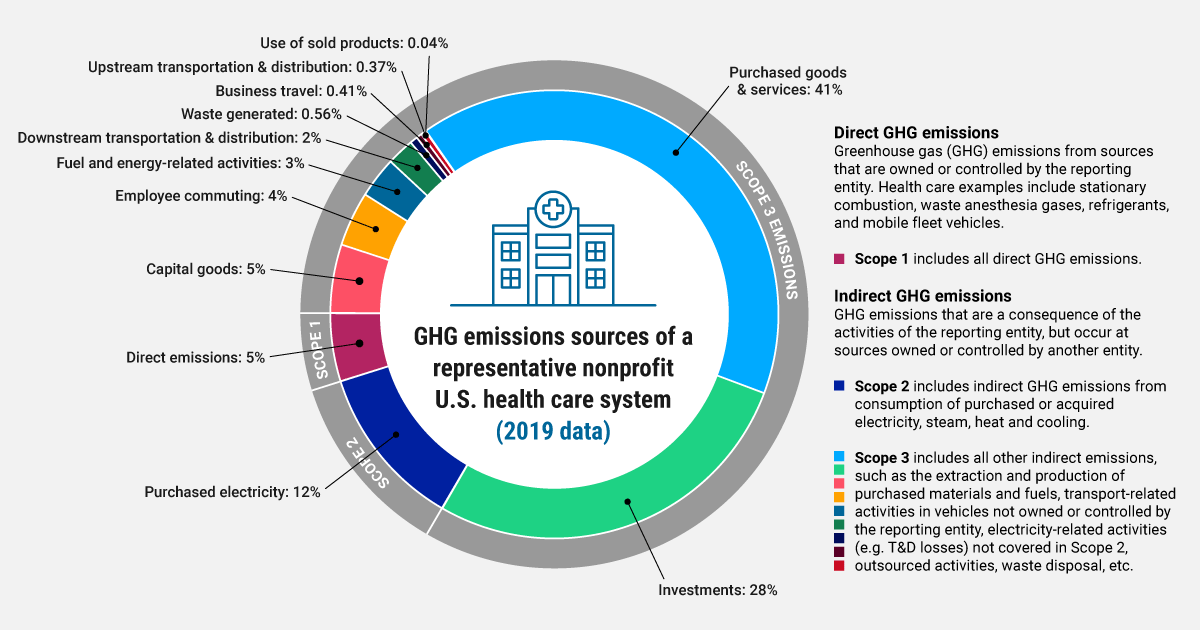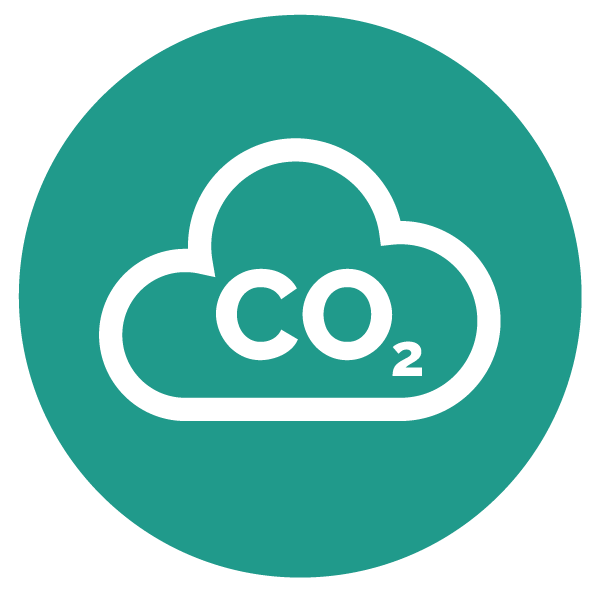John Ullman, director of procurement and safer chemicals
Emily Mediate, chief program officer
After vulnerabilities came to light during the COVID-19 pandemic, health care systems are rethinking their supply chains and businesses are reconsidering their procurement policies in an era of new regulations and incentives. Hospitals are shifting procurement practices to consider their impact on pollution, use of chemicals of concern, and obligations to local communities and economies. If the health care sector can fully implement and leverage this important transformation, we will see sweeping changes flow to other business sectors, higher education, and government.
Glove pollution is out of hand
Consider a product common in every outpatient office, clinic, center, and hospital across the country: disposable examination gloves. While it may seem intuitive that gloves are necessary for every patient interaction, that isn’t always the case. Gloves are the highest-volume disposable product purchased by health care and can often be misused. One study found that 6% of gloves are wasted simply by falling on the floor because of poor packaging.
The environmental impacts from glove overuse are substantial, particularly due to manufacturers’ reliance on petrochemicals and resultant GHG emissions. A study during the pandemic found that 45% of the environmental impact of personal protective equipment was due to gloves. Additionally, gloves pose potential health hazards to both patients and health care workers as the chemicals they are made from are easily absorbed through the skin. They can cause hypersensitivity reactions and potential chronic risks associated with ortho-phthalates and other additives. Hospitals can apply sustainable procurement principles to address existing problems while spurring innovation to decarbonize and detoxify the glove marketplace.
Reuse and redesign: Problem-solving for plastics
In the United States, 20% to 25% of the 14,000 tons of waste generated daily by hospitals is plastic, and global production of health care plastics is estimated to increase by 50% from 2020 to 2025. To combat this, hospitals are moving toward renewable energy and the broader economy is transitioning to clean energy – spurred in part by the monumental Inflation Reduction Act’s $369 billion strategic investments.

Medical facilities are using several strategies to reduce the harm caused by plastics, as part of their efforts to address the climate crisis. First and foremost, they are reducing plastics, a critical need as a significant portion of plastic materials and packaging are often not even used, let alone utilized in an evidence-based manner.
Switching to reusable materials and reprocessing devices are effective strategies. UCLA Medical Center discovered it had been generating more than 200 tons of landfill waste from the disposal of single-use isolation gowns each year. By transitioning to reusable gowns, the medical center reduced their waste and saved about $450,000 per year. Moreover, at the onset of the pandemic, they did not face the gown shortages that other facilities experienced. Some life cycle inventories estimate that reusable gowns can cut GHG emissions by one-third relative to disposables. As UCLA demonstrated, changing procurement practices can save money and fortify the supply chain all while reducing waste, plastic pollution, and GHG emissions. Facilities can consider contracting with a local business to launder and sanitize the reusable gowns, further contributing to the local economy while fostering community resilience.

Kaiser Permanente used their substantial purchasing power to drive market transformation by working with two of their suppliers to redesign disinfectant wipe containers that proved to be problematic in numerous ways. For years, the wipe containers they used were made of rigid plastic, making them bulky for transportation and storage. Liquid disinfectants pooled in the bottom of the containers, requiring them to be disposed of as costly hazardous waste. Through an iterative and collaborative process, they developed new packaging similar to the kind used for soft baby wipes. Kaiser Permanente has since benefited from more than $2 million in cost savings, smaller transportation and storage footprints, and containers that require about 80% less plastic than the original containers.

Decarbonizing via smarter purchasing
More than 1,180 federal and private sector hospitals have made major climate commitments, together representing over 15% of U.S. hospitals.
Decarbonizing the health care supply chain is especially critical for U.S. hospitals to achieve their climate goals. More than 82% of the sector’s emissions are derived from indirect emissions known as Scope 3. More specifically, the purchasing and distribution of goods and services alone are responsible for almost 50% of a typical hospital’s emissions.
The Biden Administration and Paris Agreement targets are driving action in the health care sector, and there is significant momentum to decarbonize. More than 800 hospitals in the United States have signed the White House Health and Human Services Health Sector Climate Pledge, committing to emissions reduction and climate resilience goals. Federal systems like the Indian Health Service, Veterans Health Administration, and Military Health System are working together to meet similar goals under an executive order. Combined, more than 1,180 federal and private sector hospitals have made major climate commitments, representing over 15% of U.S. hospitals.
Health Care Without Harm and Practice Greenhealth are working directly with health care facilities, and key allies in the health sector, to baseline and reduce Scope 3 emissions. Our Health Care Emissions Impact Calculator can help health systems and hospitals calculate their emissions across all 15 GHG protocol categories, including those related to procurement. Facilities can then approach their top suppliers and require them to follow the Climate Excellence Standard to reduce their emissions and thereby the Scope 3 emissions for health care purchasers.

Cutting into the meat of Scope 3
One important, but often forgotten hospital Scope 3 emissions category is food. In fact, the EAT-Lancet Commission concluded that even if all global emissions reduction efforts are achieved, without a shift in dietary patterns, the world will fail to meet the goals of the Paris Agreement. The IPCC estimates that agriculture and associated land-use changes are responsible for 24% of global GHG emissions, and livestock production alone is responsible for approximately 14.5% of global GHG emissions.
Hospitals are reducing the amount of animal products purchased and served using procurement and plant-forward menu design strategies. They are also purchasing foods sourced from farmers and producers using sustainable methods such as organic and regenerative farming. 130 hospitals have joined the Coolfood Pledge with a goal to reduce GHG emissions from food purchases by 25% by 2030 (or 38% per plate GHG reduction over that period). In just a few years, these hospitals achieved an average per plate reduction of 21% while increasing their service of plant-based foods by 27%.
In New England, hospitals collaborated with local farmers and food producers to develop a yellow pea fritter for their menus. This delicious and now-popular plant-based product created a new market for a crop that enhances soil fertility while supporting local farmers and food processors. In addition to reducing the impacts of climate change, innovative partnerships like this can strengthen the resilience of regional food supply chains, increase economic opportunities, and even address community health and food insecurity.
Maximizing the benefits of health care purchasing power

Leading health care organizations are advancing health equity by supporting local economies with livable wages, education, housing, and job creation, while simultaneously strengthening communities and creating wealth for current and future generations. In 2021, the Healthcare Anchor Network, in partnership with Health Care Without Harm and Practice Greenhealth, launched the Impact Purchasing Commitment to create a holistic, multipronged approach for hospitals to address key determinants of a healthy community. In doing so they have directed their purchasing power to support supplier diversity, community wealth building, and environmental sustainability. As just one example of the commitment, the original 12 signatories committed to increase their spending on businesses owned by women and people of color by a total of $1 billion by 2025.
Practice Greenhealth partners can access the Sustainable procurement in health care guide, which provides step-by-step guidance, tools, and resources to develop a sustainable purchasing strategy. Additional resources are available for all purchasers on the Practice Greenhealth website.
Selected resources
|
Image
Anchored by Health Systems: Strategies for Health Care - Case studies and recommendations to support hospitals in evaluating, strategizing, and operationalizing their approach as anchor institutions in creating ecologically sustainable, equitable, and healthy communities. |
|
Image

Anesthetic gas how-to guide - For baselining and finding alternatives with lower GHG emissions. Climate action playbook for hospitals - Success stories that demonstrate hospitals’ commitment to climate action. |
|
Image

Greenhealth Approved - A product seal that helps identify products that meet sustainability criteria developed by Health Care Without Harm. Choosing products that carry the seal reduces the research burden for health care staff. Furniture, carpet, resilient flooring, and gloves are among the first categories. |
|
Image

Climate Excellence Standard for health sector suppliers - In partnership with the U.S. Health Care Climate Council, the standard defines superior performance in decarbonization on the part of individual suppliers to ensure the health care supply chain is aligned with achieving robust GHG emissions reduction in alignment with goals to achieve net-zero emissions by 2050. |
|
Image

Healthy Food in Health Care Standard - Guides for hospitals to develop a comprehensive approach using their purchasing and programs to help build a just, healthy, and sustainable food system. The included Food purchasing criteria guides facilities on the product attributes (eco-labels, definitions, etc) to prioritize in their purchasing. |
|
Image

Decarbonization roadmap for health systems & medtech suppliers - Through a partnership with Kaiser Permanente, Accenture, Practice Greenhealth, and Health Care Without Harm, the roadmap consolidates feedback from a round table of key procurement and supply chain stakeholders, and identifies collective actions that can be pursued. |
The development of this piece was supported by the Commonwealth Fund, a national, private foundation based in New York City that supports independent research on health care issues and makes grants to improve health care practice and policy. The views presented here are those of the authors and not necessarily those of the Commonwealth Fund, its directors, officers, or staff.